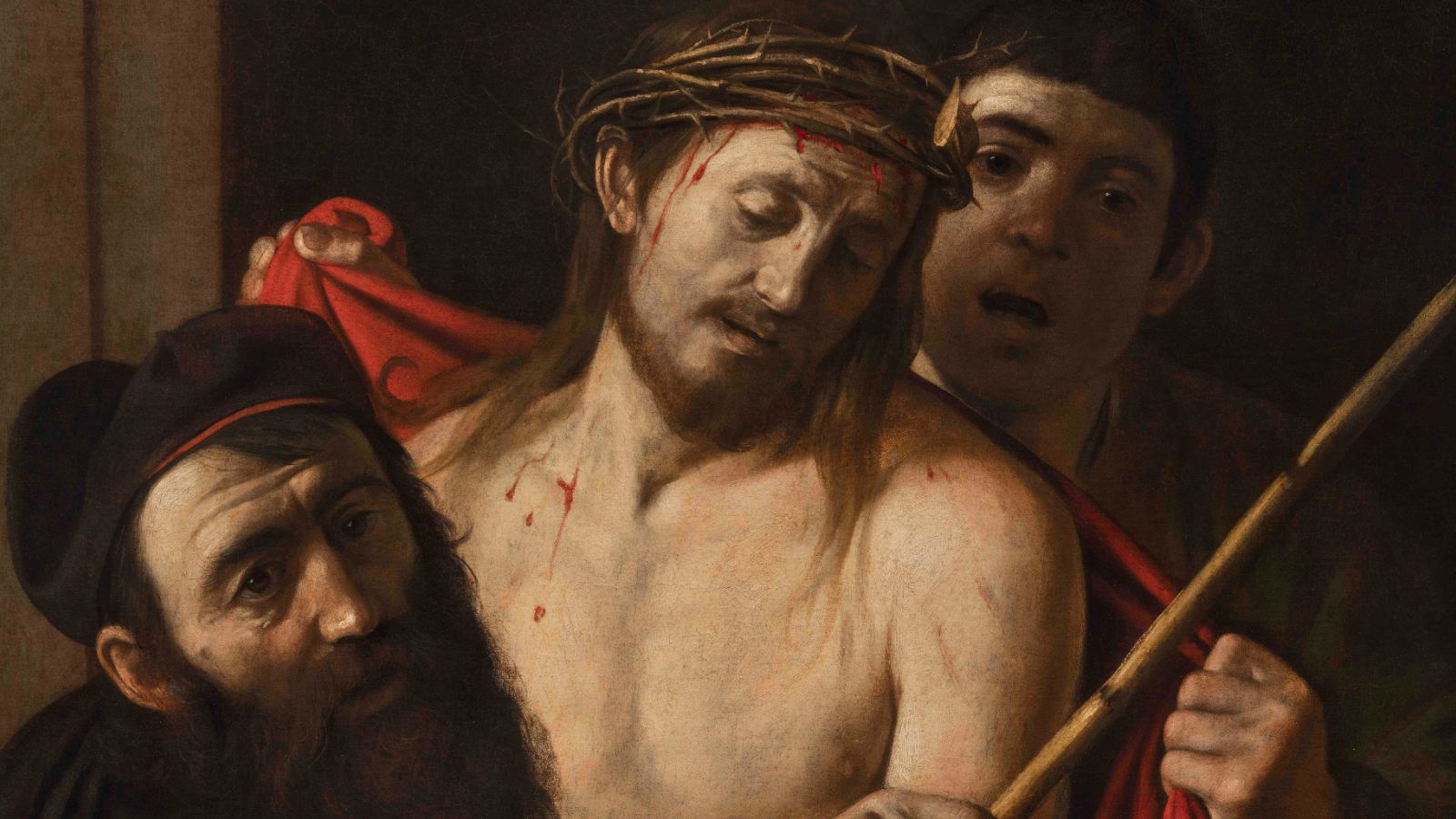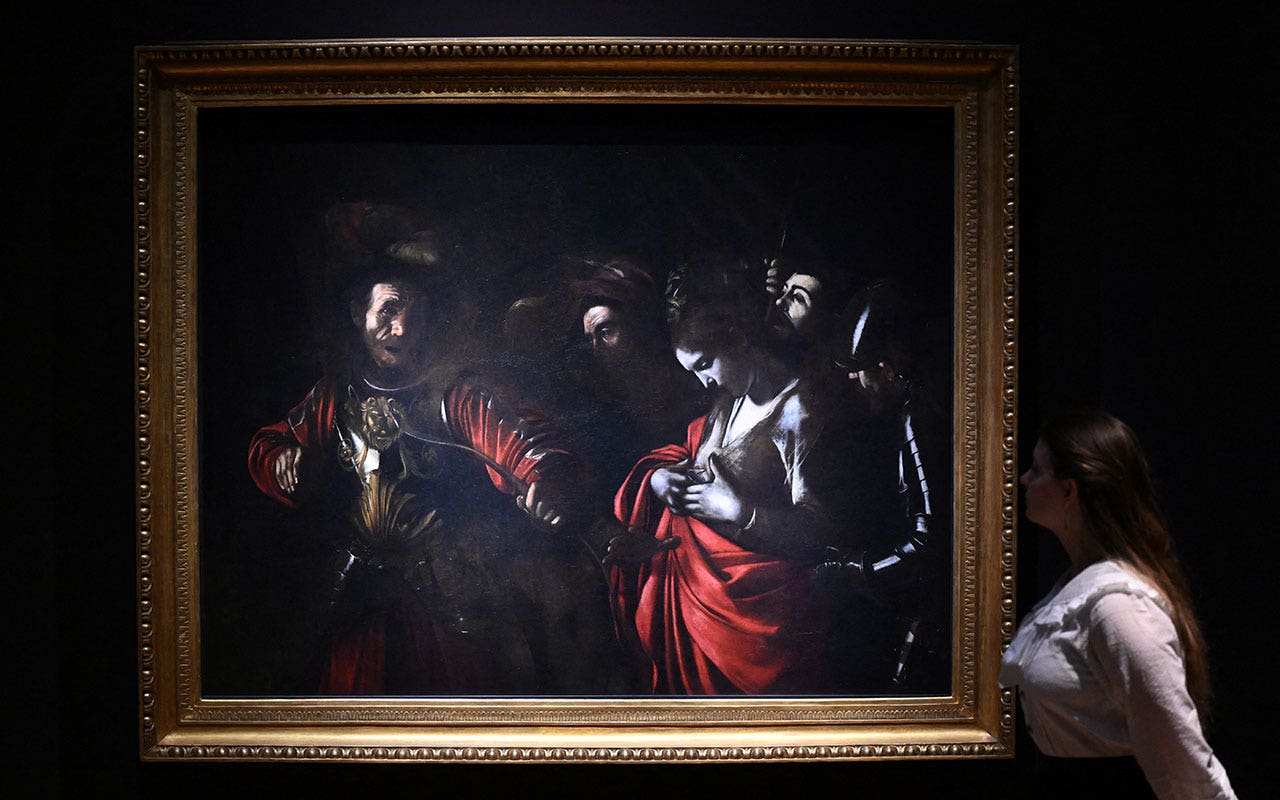
The Prado Museum in Spain confirmed a painting titled Ecce Homo, previously believed to be by a Spanish artist, as a lost work of Italian master Caravaggio. Dating back to 1605-09, the painting was part of King Phillip IV of Spain's collection and is one of only 60 known Caravaggio paintings. After being in a Madrid family's possession since the 19th century, it was recently sold to an individual who wanted it displayed at the Prado Museum. The oil-on-canvas artwork depicts the Biblical scene of Jesus Christ being presented to the crowds before crucifixion.

Ecce Homo (c. 1605/06 or 1609 according to John Gash) is a painting by the Italian Baroque master Caravaggio. It is housed in the Palazzo Bianco, Genoa. Contemporary accounts claim the piece was part of a unannounced competition between three artists, and that the Caravaggio version was eventually sent to Spain.

The Ecce Homo (Latin: "Behold the Man") in the Sanctuary of Mercy church in Borja, Spain, is a fresco painted circa 1930 by the Spanish painter Elías García Martínez depicting Jesus crowned with thorns. Both the subject and style are typical of traditional Catholic art.While press accounts agree that the original painting was artistically unremarkable, its current fame derives from a good faith attempt to restore the fresco by Cecilia Giménez, an untrained amateur artist, in 2012. The intervention transformed the painting and made it look similar to a monkey, and for this reason it is sometimes referred to as Ecce Mono (roughly Behold the Monkey, "mono" being Spanish for "monkey").

Ecce Homo is a painting of the episode in the Passion of Jesus by the Early Netherlandish painter Hieronymus Bosch, painted between 1475 and 1485. The original version, with a provenance in collections in Ghent, is in the Städel Museum in Frankfurt; a copy is held the Museum of Fine Arts in Boston. The painting takes its title from the Latin words Ecce Homo, "Behold the Man" spoken by the Roman Prefect Pontius Pilate when Jesus is paraded before a baying, angry mob in Jerusalem before he is sentenced to be crucified.

Christ Crucified is a 1632 painting by Diego Velázquez depicting the Crucifixion of Jesus. The work, painted in oil on canvas, measures 249 × 170 cm and is owned by the Museo del Prado.

Ecce Homo or Christ Wearing the Crown of Thorns is an oil on oak panel painting of the Ecce Homo subject by Peter Paul Rubens, executed c. 1612, now in the Hermitage Museum, in Saint Petersburg. The Hermitage also houses an oil study for its figure of Pilate.Originally commissioned by cardinal Massimego, Christ's pose was influenced by the statue of a centaur in the Borghese Gallery in Rome and the work may even have been produced as a pendant to the 1616-1617 Drunken Silenus (Alte Pinakothek). H. Evers argues it was produced during the artist's stay in Genoa, whilst Keizer argues it was from Rubens' later period in Antwerp. By the end of the 18th century it was in Prince Bezborodko's collection in Saint Petersburg. It passed by inheritance to his relatives-in-law, the Counts Kushelev; on his death in 1862, Count Nikolai Kushelev-Bezborodko bequested the collection to the Academy of Arts.

Ecce homo (, Ecclesiastical Latin: [ˈettʃe ˈomo], Classical Latin: [ˈɛkkɛ ˈhɔmoː]; "behold the man") are the Latin words used by Pontius Pilate in the Vulgate translation of the Gospel of John, when he presents a scourged Jesus, bound and crowned with thorns, to a hostile crowd shortly before his Crucifixion (John 19:5). The original New Testament Greek: "ἰδοὺ ὁ ἄνθρωπος", romanized: "idoù ho ánthropos", is rendered by most English Bible translations, e.g. the Douay-Rheims Bible and the King James Version, as "behold the man". The scene has been widely depicted in Christian art.A scene of the ecce homo is a standard component of cycles illustrating the Passion and life of Christ in art. It follows the stories of the Flagellation of Christ, the crowning with thorns and the mocking of Jesus, the last two often being combined: The usual depiction shows Pilate and Jesus, a mocking crowd which may be rather large, and parts of the city of Jerusalem.But, from the 15th century in the West, and much earlier in the art of the Eastern church, devotional pictures began to portray Jesus alone, in half or full figure with a purple robe, loincloth, crown of thorns and torture wounds, especially on his head, and later became referred to as images of the Ecce homo. Similar subjects but with the wounds of the crucifixion visible (Nail wounds on the limbs, spear wounds on the sides), are termed a Man of Sorrows (also Misericordia). If the instruments of the Passion are present, it may be called an Arma Christi. If Christ is sitting down (usually supporting himself with his hand on his thigh), it may be referred to it as Christ at rest or Pensive Christ. It is not always possible to distinguish these subjects.

The Beheading of Saint John the Baptist is an oil painting by the Italian artist Caravaggio. Measuring 3.7 m by 5.2 m, it depicts the execution of John the Baptist. It is located in the Oratory of St. John's Co-Cathedral in Valletta, Malta.According to Andrea Pomella in Caravaggio: An Artist through Images (2005), the work is widely considered to be Caravaggio's masterpiece as well as "one of the most important works in Western painting." Jonathan Jones has described The Beheading of Saint John the Baptist as one of the ten greatest works of art of all time: "Death and human cruelty are laid bare by this masterpiece, as its scale and shadow daunt and possess the mind."

The Crucifixion of Saint Peter (Italian: Crocifissione di san Pietro) is a work by Michelangelo Merisi da Caravaggio, painted in 1601 for the Cerasi Chapel of Santa Maria del Popolo in Rome. Across the chapel is a second Caravaggio work depicting the Conversion of Saint Paul on the Road to Damascus (1601). On the altar between the two is the Assumption of the Virgin Mary by Annibale Carracci.

Judith Beheading Holofernes is a painting of the biblical episode by Caravaggio, painted in c. 1598–1599 or 1602, in which the widow Judith stayed with the Assyrian general Holofernes in his tent after a banquet then decapitated him after he passed out drunk. The painting was rediscovered in 1950 and is part of the collection of the Galleria Nazionale d'Arte Antica in Rome. The exhibition 'Dentro Caravaggio' Palazzo Reale, Milan (Sept 2017-Jan 2018), suggests a date of 1602 on account of the use of light underlying sketches not seen in Caravaggio's early work but characteristic of his later works. The exhibition catalogue (Skira, 2018, p88) also cites biographer artist Giovanni Baglione's account that the work was commissioned by Genoa banker Ottavio Costa.A second painting on the exact same subject (see below) and dated to 1607, attributed by several experts to Caravaggio but still disputed by others, was rediscovered by chance in 2014 and went on sale in June 2019 as "Judith and Holofernes".

"Ecce homo" (Latin: "Behold the Man"), is a phrase traditionally attributed to Pontius Pilate at the trial of Jesus.Ecce Homo may also refer to:

The Prado Mona Lisa is a painting by the workshop of Leonardo da Vinci and depicts the same subject and composition as Leonardo's better known Mona Lisa at the Louvre, Paris. The Prado Mona Lisa has been in the collection of the Museo del Prado in Madrid, Spain since 1819, but was considered for decades a relatively unimportant copy. Following its restoration in 2012, however, the Prado's Mona Lisa has come to be understood as the earliest known studio copy of Leonardo's masterpiece.Although there are dozens of surviving copies of the Mona Lisa from the 16th and 17th centuries, the Prado's Mona Lisa may have been painted simultaneously by a student of Leonardo in the same studio where he painted his own Mona Lisa, so it is said to be the copy with the most historical value. Among the pupils of Leonardo, Salaì or Francesco Melzi are the most plausible authors of the Prado's version, though other experts argue that the painting could have been executed by one of Leonardo's Spanish students.

The Museo del Prado ( PRAH-doh; Spanish pronunciation: [muˈseo ðel ˈpɾaðo]), officially known as Museo Nacional del Prado, is the main Spanish national art museum, located in central Madrid. It houses collections of European art, dating from the 12th century to the early 20th century, based on the former Spanish royal collection, and the single best collection of Spanish art. Founded as a museum of paintings and sculpture in 1819, it also contains important collections of other types of works. The numerous works by Francisco Goya, the single most extensively represented artist, as well as by Hieronymus Bosch, El Greco, Peter Paul Rubens, Titian, and Diego Velázquez, are some of the highlights of the collection. Velázquez and his keen eye and sensibility were also responsible for bringing much of the museum's fine collection of Italian masters to Spain, now one of the largest outside of Italy.The collection currently comprises around 8,200 drawings, 7,600 paintings, 4,800 prints, and 1,000 sculptures, in addition to many other works of art and historic documents. As of 2012, the museum displayed about 1,300 works in the main buildings, while around 3,100 works were on temporary loan to various museums and official institutions. The remainder were in storage. Due to the COVID-19 pandemic, in 2020 attendance plunged by 76 percent to 852,161. Nonetheless, the Prado was ranked as the 16th most-visited museum in the list of most-visited art museums in the world in 2020. It is one of the largest museums in Spain.The Prado, with the nearby Thyssen-Bornemisza Museum and the Museo Reina Sofía, forms Madrid's Golden Triangle of Art, which was included in the UNESCO World Heritage list in 2021.

David with the Head of Goliath is a painting by the Italian Baroque artist Caravaggio. It is housed in the Galleria Borghese, Rome. The painting, which was in the collection of Cardinal Scipione Borghese in 1650, has been dated as early as 1605 and as late as 1609–1610, with more recent scholars tending towards the former.Caravaggio also treated this subject in a work dated c. 1607 in the Kunsthistorisches Museum in Vienna, and in an early work dated c. 1600 in the Prado in Madrid.The immediate inspiration for Caravaggio was a work by a follower of Giorgione, c.1510, but Caravaggio captures the drama more effectively by having the head dangling from David's hand and dripped out blood, rather than resting on a ledge. The sword in David's hand carries an abbreviated inscription H-AS OS; this has been interpreted as an abbreviation of the Latin phrase humilitas occidit superbiam ("humility kills pride").David is perturbed, "his expression mingling sadness and compassion." The decision to depict him as pensive rather than jubilant creates an unusual psychological bond between him and Goliath. This bond is further complicated by the fact that Caravaggio has depicted himself as Goliath, while the model for David is il suo Caravaggino ("his own little Caravaggio"). This most plausibly refers to Cecco del Caravaggio, the artist's studio assistant in Rome some years previously, recorded as the boy "who lay with him." No independent portraits of Cecco are known, making the identification impossible to verify, but "[a] sexual intimacy between David/model and Goliath/painter seems an inescapable conclusion, however, given that Caravaggio made David's sword appear to project upward, suggestively, between his legs and at an angle that echoes the diagonal linking of the protagonist's gaze to his victim." Alternatively, based on the portrait of Caravaggio done by Ottavio Leoni, this may be a double self-portrait. The young Caravaggio (his own little Caravaggio) wistfully holds the head of the adult Caravaggio. The wild and riotous behavior of the young Caravaggio essentially had destroyed his life as a mature adult, and he reflects with a familiar hermeticism on his own condition in a painting of a related religious subject.The masterpiece in Rome is a "twin" of a second artwork on the same subject, David and Goliath, as reported in the inventory of the Galleria Borghese dated 1693, where is found that one was located in the first room, and the other in the fourth room. According to his biographer Bellori, the artwork had been commissioned to Caravaggio by Cardinal Scipione Borghese in 1606, a work that is possibly performed on a double easel, thus generating two twin masterpieces.The biographical interest of the painting adds another layer of meaning to an already complex work, David and Goliath standing for Christ and Satan and the triumph of good over evil in orthodox Christian iconography of the period, and also as the cold-hearted beloved who "kills" and his lover according to contemporary literary conceit. An example of the genre can be seen in the contemporary Judith and Holofernes of Cristofano Allori in the Pitti Palace, where Allori depicts himself as Holofernes, although Caravaggio has depicted David not as cruel and indifferent but as deeply moved by Goliath's death.If the painting was a gift to Cardinal Borghese, the papal official with the power to grant Caravaggio a pardon for murder, it can also be interpreted as a personal plea for mercy. "David with the Head of Goliath [thus] demonstrates Caravaggio's gift for distilling his own experiences into an original sacred imagery that transcends the personal to become a searing statement of the human condition." Here the complicated relationship between Caravaggio and his acquired child lover is on display. Not only is Caravaggio at this point a hunted murderer but also in a relationship with a man who Caravaggio procured and no doubt raped as a child. Caravaggio's self loathing is palpable.

The Mona Lisa ( MOH-nə LEE-sə; Italian: Gioconda [dʒoˈkonda] or Monna Lisa [ˈmɔnna ˈliːza]; French: Joconde [ʒɔkɔ̃d]) is a half-length portrait painting by Italian artist Leonardo da Vinci. Considered an archetypal masterpiece of the Italian Renaissance, it has been described as "the best known, the most visited, the most written about, the most sung about, [and] the most parodied work of art in the world". The painting's novel qualities include the subject's enigmatic expression, monumentality of the composition, the subtle modelling of forms, and the atmospheric illusionism.The painting has been traditionally considered to depict the Italian noblewoman Lisa del Giocondo. It is painted in oil on a white Lombardy poplar panel. Leonardo never gave the painting to the Giocondo family. It was believed to have been painted between 1503 and 1506; however, Leonardo may have continued working on it as late as 1517. King Francis I of France acquired the Mona Lisa after Leonardo's death in 1519, and it is now the property of the French Republic. It has normally been on display at the Louvre in Paris since 1797.The painting's global fame and popularity partly stem from its 1911 theft by Vincenzo Peruggia, who attributed his actions to Italian patriotism—a belief it should belong to Italy. The theft and subsequent recovery in 1914 generated unprecedented publicity for an art theft, and led to the publication of many cultural depictions such as the 1915 opera Mona Lisa, two early 1930s films (The Theft of the Mona Lisa and Arsène Lupin) and the song "Mona Lisa" recorded by Nat King Cole—one of the most successful songs of the 1950s.The Mona Lisa is one of the most valuable paintings in the world. It holds the Guinness World Record for the highest known painting insurance valuation in history at US$100 million in 1962, equivalent to $1 billion as of 2023.

On Good Friday, May 3, 2024, the procession of Epitaphios, the bier carrying the body of Jesus Christ to his grave, took place in Nafpaktos, western Greece. The solemn processions in Greece feature flower-adorned biers followed by clergy and faithful, leading to a stunning display where processions from different parishes meet at the Venetian port. Pilgrims gathered to witness this annual event.

Narcissus is a painting by the Italian Baroque master Caravaggio, painted circa 1597–1599. It is housed in the Galleria Nazionale d'Arte Antica in Rome.The painting was originally attributed to Caravaggio by Roberto Longhi in 1916. This is one of only two known Caravaggios on a theme from Classical mythology, although this is due more to the accidents of survival than the artist's oeuvre. Narcissus, according to the poet Ovid in his Metamorphoses, is a handsome youth who falls in love with his own reflection. Unable to tear himself away, he dies of his passion, and even as he crosses the Styx continues to gaze at his reflection (Metamorphoses 3:339–510).

The Thyssen-Bornemisza National Museum (Spanish: Museo Nacional Thyssen-Bornemisza, pronounced [muˈseo ˈtisem boɾneˈmisa]; named after its founder, Baron Heinrich Thyssen-Bornemisza), or simply the Thyssen, is an art museum in Madrid, Spain, located near the Prado Museum on one of the city's main boulevards. It is known as part of the "Golden Triangle of Art", which also includes the Prado and the Reina Sofía national galleries. The Thyssen-Bornemisza fills the historical gaps in its counterparts' collections: in the Prado's case this includes Italian primitives and works from the English, Dutch and German schools, while in the case of the Reina Sofía it concerns Impressionists, Expressionists, and European and American paintings from the 20th century.With over 1,600 paintings, it was once the second largest private collection in the world after the British Royal Collection. A competition was held to house the core of the collection in 1987–88 after Baron Thyssen, having unsuccessfully sought permission to enlarge his museum in Lugano (Villa Favorita), searched for a better-suited location elsewhere in Europe.

The following is a list of paintings by the Italian artist Caravaggio, listed chronologically.

Ruben Enaje, a 63-year-old Filipino villager, is set to be nailed to a wooden cross for the 35th time to reenact Jesus Christ's suffering on Good Friday. The annual tradition in Pampanga province draws tourists. Enaje, considering his age, continues the ritual to pray for peace in Ukraine, Gaza, and the South China Sea due to global conflicts and wars, affecting innocent people. He also mentions the impact of these conflicts on prices of oil, gas, and food in the Philippines, making life harder for the impoverished.

Michelangelo Merisi da Caravaggio (also Michele Angelo Merigi or Amerighi da Caravaggio; , US: , Italian: [mikeˈlandʒelo meˈriːzi da (k)karaˈvaddʒo]; 29 September 1571 – 18 July 1610), known mononymously as Caravaggio, was an Italian painter active in Rome for most of his artistic life. During the final four years of his life, he moved between Naples, Malta, and Sicily until his death. His paintings have been characterized by art critics as combining a realistic observation of the human state, both physical and emotional, with a dramatic use of lighting, which had a formative influence on Baroque painting.Caravaggio employed close physical observation with a dramatic use of chiaroscuro that came to be known as tenebrism. He made the technique a dominant stylistic element, transfixing subjects in bright shafts of light and darkening shadows. Caravaggio vividly expressed crucial moments and scenes, often featuring violent struggles, torture, and death. He worked rapidly with live models, preferring to forgo drawings and work directly onto the canvas. His inspiring effect on the new Baroque style that emerged from Mannerism was profound. His influence can be seen directly or indirectly in the work of Peter Paul Rubens, Jusepe de Ribera, Gian Lorenzo Bernini, and Rembrandt. Artists heavily under his influence were called the "Caravaggisti" (or "Caravagesques"), as well as tenebrists or tenebrosi ("shadowists").Caravaggio trained as a painter in Milan before moving to Rome when he was in his twenties. He developed a considerable name as an artist and as a violent, touchy and provocative man. He killed Ranuccio Tommasoni in a brawl, which led to a death sentence for murder and forced him to flee to Naples. There he again established himself as one of the most prominent Italian painters of his generation. He travelled to Malta and on to Sicily in 1607 and pursued a papal pardon for his sentence. In 1609, he returned to Naples, where he was involved in a violent clash; his face was disfigured, and rumours of his death circulated. Questions about his mental state arose from his erratic and bizarre behavior. He died in 1610 under uncertain circumstances while on his way from Naples to Rome. Reports stated that he died of a fever, but suggestions have been made that he was murdered or that he died of lead poisoning.Caravaggio's innovations inspired Baroque painting, but the latter incorporated the drama of his chiaroscuro without the psychological realism. The style evolved and fashions changed, and Caravaggio fell out of favour. In the 20th century, interest in his work revived, and his importance to the development of Western art was reevaluated. The 20th-century art historian André Berne-Joffroy stated: "What begins in the work of Caravaggio is, quite simply, modern painting."




By CIARÁN GILES

https://www.theguardian.com/profile/samjones

ABC News

ABC News

Fox News

Sky News

Wikipedia

Wikipedia

Wikipedia

Wikipedia

Wikipedia

Wikipedia

Wikipedia

Wikipedia

Wikipedia

Wikipedia

Wikipedia

Wikipedia

Wikipedia

Wikipedia

PANORA

Wikipedia

Wikipedia

Wikipedia

PANORA

Wikipedia